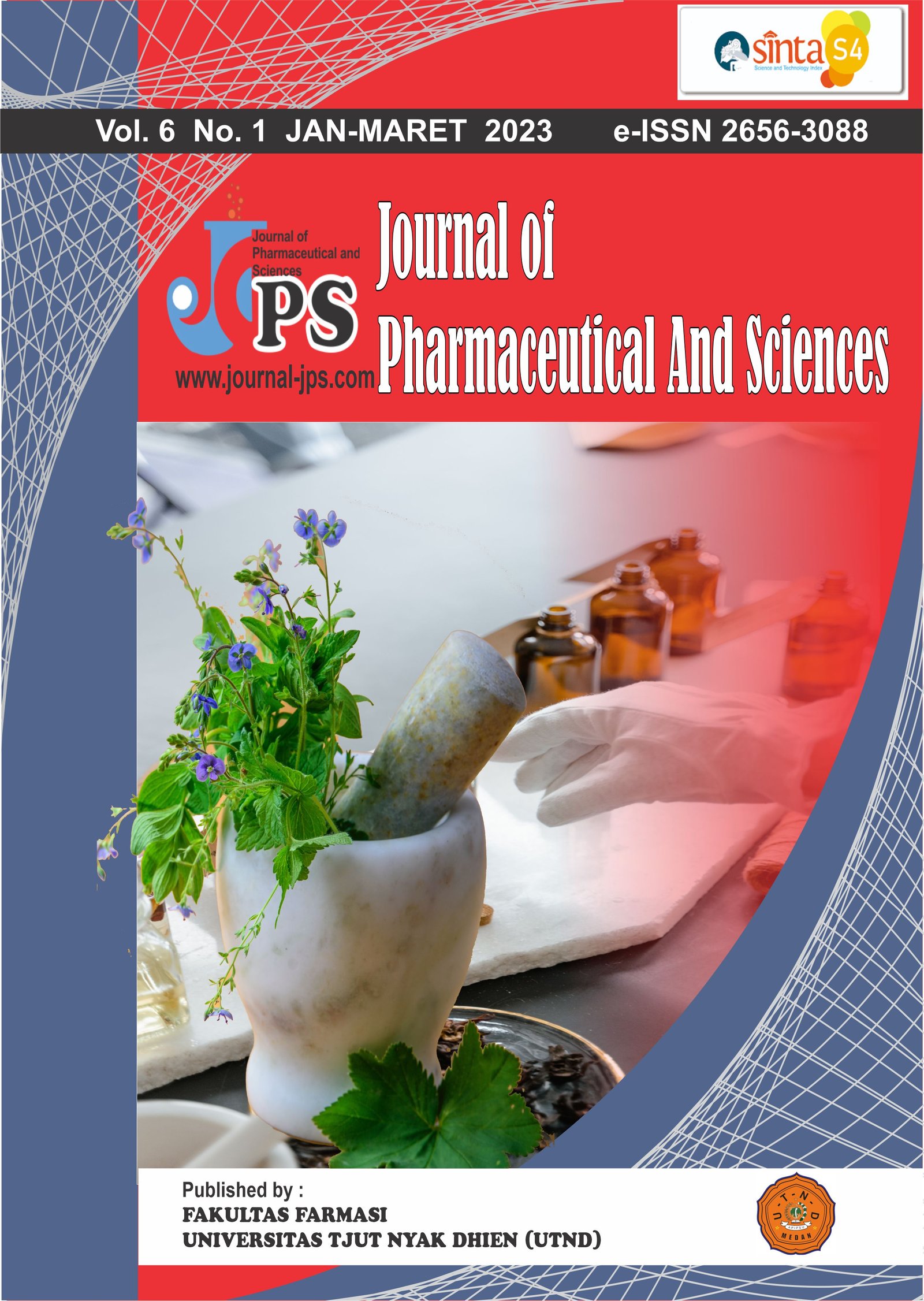Article Review: Effect of pH on Bacterial Growth as Traditional Medicines Quality Specification in Indonesia
Main Article Content
Page: 287-291
Abstract
Traditional medicine comes from safe ingredients, namely, parts of plants. Based on BPOM No. 32 of 2019, several bacteria are required for the quality of traditional medicines in Indonesia, including Escherichia coli, Clostridia, Salmonella, and Shigella. An optimal pH medium is also needed in the microbial contamination test to produce optimal bacterial growth data. The method used is library search using electronic databases such as Google Scholar and Pubmed with the keywords "Effect of pH on bacterial growth" and other keywords related to microbes and types of bacterial contamination. The inclusion criteria were the sources published in the last ten years, either in English or Indonesian, with exclusion criteria being any sources published that did not discuss the effect of pH on bacterial growth. A total of 24 articles were found, with the final result being 11 articles reviewed. It was found that a difference in pH of at least 0.5 can significantly affect the growth of bacteria.
Downloads
Article Details

This work is licensed under a Creative Commons Attribution-NonCommercial-ShareAlike 4.0 International License.
References
Arena, E. T., Campbell-Valois, F.-X., Tinevez, J.-Y., Nigro, G., Sachse, M., Moya-Nilges, M., … Sansonetti, P. J. (2015). Bioimage analysis of Shigella infection reveals targeting of colonic crypts. Proceedings of the National Academy of Sciences of the United States of America, 112(25), E3282-90. https://doi.org/10.1073/pnas.1509091112
Arivo, D., & Annissatussholeh, N. (2017). Pengaruh Tekanan Osmotik pH, dan Suhu Terhadap Pertumbuhan Bakteri Escherichia Coli. Jurnal Ilmu Kedokteran Dan Kesehatan, 4(3), 153–160.
Aulani, F. N. (2019). Cara BPOM Memastikan Keamanan Obat Tradisional di Masyarakat. Farmasetika.Com (Online), 3(2), 24. https://doi.org/10.24198/farmasetika.v3i2.21620
Chiang, I.-L., Wang, Y., Fujii, S., Muegge, B. D., Lu, Q., Tarr, P. I., & Stappenbeck, T. S. (2021). Biofilm Formation and Virulence of Shigella flexneri Are Modulated by pH of Gastrointestinal Tract. Infection and Immunity, 89(11), e0038721. https://doi.org/10.1128/IAI.00387-21
Denamur, E., Clermont, O., Bonacorsi, S., & Gordon, D. (2021). The population genetics of pathogenic Escherichia coli. Nature Reviews. Microbiology, 19(1), 37–54. https://doi.org/10.1038/s41579-020-0416-x
Khalil, I. A., Troeger, C., Blacker, B. F., Rao, P. C., Brown, A., Atherly, D. E., … Reiner, R. C. J. (2018). Morbidity and mortality due to shigella and enterotoxigenic Escherichia coli diarrhoea: the Global Burden of Disease Study 1990-2016. The Lancet. Infectious Diseases, 18(11), 1229–1240. https://doi.org/10.1016/S1473-3099(18)30475-4
Kim, C., Bushlaibi, M., Alrefaei, R., Ndegwa, E., Kaseloo, P., & Wynn, C. (2019). Influence of prior pH and thermal stresses on thermal tolerance of foodborne pathogens. Food Science & Nutrition, 7(6), 2033–2042. https://doi.org/10.1002/fsn3.1034
Li, T., Tian, R., Cai, K., Wang, Q., Chen, F., Fang, H., … Wang, H. (2013). The effect of pH on growth of clostridium botulinum type a and expression of bontA and botR during different growth stages. Foodborne Pathogens and Disease, 10(8), 692–697. https://doi.org/10.1089/fpd.2012.1457
Merialdi, G., Ramini, M., Parolari, G., Barbuti, S., Frustoli, M. A., Taddei, R., … Cozzolino, P. (2016). Study on potential clostridium botulinum growth and toxin production in Parma ham. Italian Journal of Food Safety, 5(2), 69–74. https://doi.org/10.4081/ijfs.2016.5564
NHS. (2022). Herbal Medicines. Retrieved August 6, 2022, from https://www.nhs.uk/conditions/herbal-medicines/#:~:text=Herbal medicines are those with,harmful if not used correctly.
Organization, W. H. (2018). Salmonella (non-typhoidal). Retrieved November 6, 2022, from https://www.who.int/news-room/fact-sheets/detail/salmonella-(non-typhoidal)
Parija, S. C. (2012). Microbiology Immunology (2nd ed.). India: Elsevier.
Pelczar, M. J., Chan, E. C. S., & Hadioetomo, R. S. (1988). Dasar-dasar mikrobiologi. Penerbit Universitas Indonesia. Retrieved from https://books.google.co.id/books?id=Wts8nwEACAAJ
Riley, L. W. (2020). Distinguishing Pathovars from Nonpathovars: Escherichia coli. Microbiology Spectrum, 8(4). https://doi.org/10.1128/microbiolspec.AME-0014-2020
Sulistiyoningrum, R., Suprijanto, J., & Sabdono, A. (2013). AKTIVITAS ANTI BAKTERI KITOSAN DARI CANGKANG KERANG SIMPING PADA KONDISI LINGKUNGAN YANG BERBEDA : KAJIAN PEMANFAATAN LIMBAH KERANG SIMPING (Amusium sp.). Journal Of Marine Research., Vol. 2, pp. 111–117. https://doi.org/10.1038/141548c0
The, H. C., Thanh, D. P., Holt, K. E., Thomson, N. R., & Baker, S. (2016). The genomic signatures of Shigella evolution, adaptation and geographical spread. Nature Reviews. Microbiology, 14(4), 235–250. https://doi.org/10.1038/nrmicro.2016.10
Tiwari, A., & Nagalli, S. (2022). Clostridium Botulinum. Treasure Island (FL).
Utami, S., Bintari, S. H., & Susanti, R. (2018). Deteksi Escherichia coli pada jamu gendong di gunungpati dengan medium selektif diferensial. Life Science, 7(2), 73–81.
Viana Brandi, I., Domenici Mozzer, O., Jorge, E. Vander, Vieira Passos, F. J., Lopes Passos, F. M., Cangussu, A. S. R., & Macedo Sobrinho, E. (2014). Growth conditions of clostridium perfringens type B for production of toxins used to obtain veterinary vaccines. Bioprocess and Biosystems Engineering, 37(9), 1737–1742. https://doi.org/10.1007/s00449-014-1146-0
Wetzel, D., & McBride, S. M. (2020). The impact of pH on clostridioides difficile sporulation and physiology. Applied and Environmental Microbiology, 86(4). https://doi.org/10.1128/AEM.02706-19
World Health Organization. (2022). Traditional, Complementary and Integrative Medicine. Retrieved from https://www.who.int/health-topics/traditional-complementary-and-integrative-medicine#tab=tab_1





